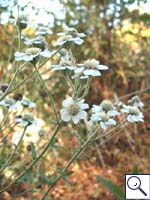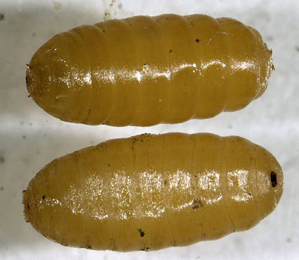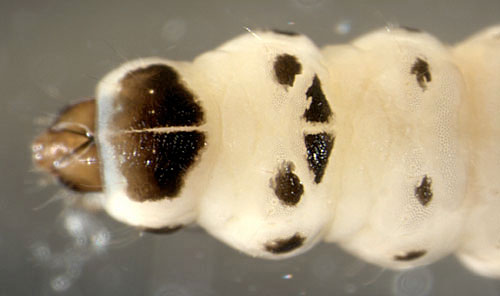 |
| |
(Coleoptera, Diptera, Hymenoptera and Lepidoptera)
by
Brian Pitkin, Willem Ellis, Colin Plant and Rob Edmunds
|
|
|
|
ACHILLEA.
Sneezeworts and Yarrow. [Asteraceae]
|
|
More than seventeen
species of Achillea are recorded in Britain. These include
the native Yarrow (A. millefolium) and Sneezewort (A.
ptarmica) and the introduced Fern-leaf Yarrow (A. filipendulina).
Twenty British miners (Diptera and non-Diptera) are recorded on Achillea.
Spencer
(1990) suggested that the host of the agromyzid Liriomyza
hampsteadensis was Achillea millefolium, but its
life-style is unknown.
A key to the European miners recorded on Achillea is provided in Bladmineerders van Europa. |

Sneezewort
Achillea ptarmica
|
Key for the identification of the known mines of British
Diptera recorded on Achillea
|
Note: Diptera larvae may live in a corridor mine, a corridor-blotch mine, or a blotch mine, but never in a case, a rolled or folded leaf, a tentiform mine or sandwiched between two more or less circular leaf sections in later instars. Pupation never in a cocoon. All mining Diptera larvae are leg-less maggots without a head capsule (see examples). They never have thoracic or abdominal legs. They do not have chewing mouthparts, although they do have a characteristic cephalo-pharyngeal skeleton (see examples), usually visible internally through the body wall. The larvae lie on their sides within the mine and use their pick-like mouthparts to feed on plant tissue. In some corridor miners frass may lie in two rows on alternate sides of the mine. In order to vacate the mine the fully grown larva cuts an exit slit, which is usually semi-circular (see Liriomyza huidobrensis video). The pupa is formed within the hardened last larval skin or puparium and as a result sheaths enclosing head appendages, wings and legs are not visible externally (see examples).
See Key to non-Diptera.
|
1a >
Stem miner |
2 |
1b >
Leaf miner |
3 |
2a > Stem-miner: A narrow external stem mine on upper part of stem
below flower head. Pupation external (Spencer, 1976:
246). Details of puparium unknown. |
Only
on Achillea millefolium in Britain and elsewhere. In Britain
only known from mines collected in Middlesex.
|
Liriomyza
flavopicta Hendel, 1931 [Diptera: Agromyzidae]. |
2b >Stem-miner: A
narrow, inconspicuous stem mine. Pupation at the end of the mine
(Spencer, 1976: 64).
Fine,
upper- or lower-surface corridor, ending in a thick vein. From there
the mine extends finally to the rind of the stem. There also the
pupation takes place, usually not far from the root collar. Mines
in the stem rind often are conspicuous through a red discoloration. |
On Achillea, Achillea millefolium and possibly Anthemis,
Matricaria and Medicago sativa in Britain. In Britain widespread in south, not uncommon. On Anthemis, Achillea, Artemisia, Aster, Centaurea, Clinopodium, Crepis, Hieracium, Matricaria, Reichardia, Solidago, Tanacetum, Tripleurospermum, Medicago, Satureja and Stachys elsewhere. Widespread in continental Europe.
|
Ophiomyia
curvipalpis (Zetterstedt, 1848) [Diptera: Agromyzidae]. |
3a > Leaf-miner: The
mine begins as an elongated blotch overlying a strong vein; from
there broad tunnels radiate that coalesce in the end. All frass
is concentrated at a central point in the floor of the mine. As
a result the mine has a brownish-black centre and a paler brownish
green seam. The larva often (perhaps always at daylight) rests in
the centre of the mine. Primary and secondary feeding lines as a
rule quite clear. Pupation outside the mine.
An elongated blotch centred over a vein. There are two types: greenish with a blackish centre and entirely reddish-black. |
|
|
|

Trypeta artemisiae pupariria
Image: © Willem Ellis (Bladmineerders van Europa) |
On
numerous genera of Asteraceae, including Achillea, in Britain
and elsewhere. In Britain more common in the north than in the
south. Also throughout the Palaearctic Region except the Mediterranean
and Middle Eastern areas.
|
Trypeta
artemisiae (Fabricius, 1794) [Diptera: Tephritidae]. |
3b > Leaf-miner: A
whitish-greenish blotch. Pupation external, on the ground (Spencer, 1972b: 43, fig. 140; Spencer,
1976: 306-7, fig. 552).
A
chacteristically pale whitish, usually upper-surface, primary blotch.
There is an initial corridor, but traces of it are almost always
overrun by the later blotch. The mine is quite opaque; only by opening
it can it be ascertained if the mine is still occupied. No feeding
lines are apparent. Unlike other blotch mines thay may occur here, Calycomyza mines are totally flat. Pupation outside the mine.
A whitish blotch mine occuring on the upper leaf surface. Starts with a short corridor and does not show feeding lines. Superficially similar to the lepidopterous mine made by Leucospilapteryx omissella, but the latter mine turns purple as it ages. |
|
On Artemisia and Eupatorium, but not yet on Achillea, in Britain; on Achillea, Ageratina, Artemisia, Chromolaena and Eupatorium elsewhere. Widespread in England and continental Europe.
|
Calycomyza
artemisiae (Kaltenbach, 1856) [Diptera:
Agromyzidae]. |
3c > Leaf-miner: Linear mine |
4 |
4a > Leaf-miner: A distinctive mine primarily above mid-rib, with irregular short
lateral offshoots into leaf blade. Pupation external (Spencer, 1972:
51 (fig. 172), 55; Spencer, 1976:
270, 271 (fig. 486)).
Branched,
whitish, upper-surface corridor; main axis overlying the midrib;
side branches overlying the main lateral veins. (In Campanula and Phyteuma the mine is much less branched, sometimes nothing
more than a corridor on top of the midrib). Frass in rather long
strings. Usually the mines begins as a long and narrow, shallow,
tortuous lower-surface corridor that ends upon the midrib but otherwise
is not associated with the leaf venation. Often this initial corridor
is filled with callus, and then even less conspicuous. Pupation
outside the mine.
A
linear mine on the upper surface, usually following the midrib and
showing side branches along the veins. The frass is in strings. |
|
|
Polyphagous. On more than 40 host genera in 15 families, including Achillea,
in Britain and elsewhere. Widespread throughout Britain. Also
recorded in the Republic of Ireland. Widespread in continental
Europe.
|
Liriomyza
strigata (Meigen, 1830) [Diptera: Agromyzidae]. |
4b > Leaf-miner: Mine linear, but not primarily above the midrib. |
5 |
5a > Leaf-miner: Mine
linear, frequently adjoining mid-rib (Spencer, 1972b: 73).
Upper-surface
corridor; the start may be lower-surface. Pupation outside the mine. |
Only
on Achillea ptarmica in Britain and elsewhere. Widespread
in Britain. Also occurs in west and central Europe.
|
Phytomyza
corvimontana Hering, 1930 [Diptera: Agromyzidae]. |
5b > Leaf-miner: Mine linear, whitish, both upper and lower surface. Pupation internal,
at the end of the mine with the anterior spiracles projecting through
the epidermis (Spencer, 1976:
433).
Upper-surface,
less often lower-surface corridor. Frass in isolated grains. Pupation
within the mine, usually in a lower-surface puparial chamber.
A long whitish upper surface corridor, which eventually goes lower surface. |
|
|
Two
highly polyphagous species of Chromatomyia, with indistinguishable
mines, have been recorded in Britain. These are syngenesiae (Hardy) and horticola (Goureau) which can only be distinguished by the male genitalia. Both species are widespread in Britain and elsewhere, although syngenesiae is almost entirely restricted to Asteraceae. Records on Asteraceae not based on examination of male genitalia are treated in this account as Chromatomyia 'atricornis'.
Chromatomyia 'atricornis' has been recorded on Achillea in Britain.
Chromatomyia syngenesiae and Chromatomyia
horticola are recorded on Achillea elsewhere but not yet on Achillea in Britain.
|
Chromatomyia
horticola (Goureau, 1851) [Diptera: Agromyzidae]
OR
Chromatomyia
syngenesiae Hardy, 1849 [Diptera: Agromyzidae]. |
5c > Leaf-miner: A narrow linear mine commencing on lower surface (Spencer, 1972b: 57; Spencer, 1976:
264).
Narrow
brownish corridor, either upper- or lower-surface. Frass in strings
or pearl chains. Pupation outside the mine. In small leaves the
mine can be full-depth and occupy the entire leaf. At least in Achillea millefolium mines are generally found in the top
half of the leaf. |
|
|
On Achillea ptarmica and Achillea millefolium in Britain
and elsewhere and other species of Achillea elsewhere.
Probably widespread in Britain, at least in south. Widespread
in continental Europe and also recorded from Canada.
|
Liriomyza
ptarmicae Meijere, 1925 [Diptera: Agromyzidae]. |
5d > Leaf-miner: A
narrow linear mine, even in the finest subdivisions of the leaves
(Spencer, 1972b: 77, as matricariae ; Spencer, 1976: 478).
Very
fine corridor, upper- or lower-surface, even in the narrowest leaf
segments. The corridor may be up to 14 cm long (Sehgal, 1971a).
Generally the corridor descends towards the leaf base. Frass in
pearl chains of loose grains, hardly in strings. Pupation outside
the mine.
Very fine corridor, upper- or lower-surface, even in the narrowest leaf segments. The corridor may be up to 14 cm long (Sehgal, 1971a). Generally the corridor descends towards the leaf base. Frass in pearl chains of loose grains, hardly in strings. Pupation outside the mine. |
|
On Achillea millefolium, Anacyclus pyrethrum, Anthemis, Tanacetum
vulgare, Tripleurospermum, Tripleurospermum maritimum and Tripleurospermum maritimum x inodora in Britain and other
Asteraceae elsewhere. Widespread in Britain and continental Europe.
Also recorded in Canada.
|
Phytomyza
pullula Zetterstedt, 1848 [Diptera: Agromyzidae]. |
5e > Leaf-miner: A
linear mine, frequently on lower surface at beginning; frass with
closely adjoining grains.
Upper-surface,
often brownish, corridor, in the end often occupying the width of
a leaf segment. Older segments of the mine are much less conspicuous,
lower-surface and quite shallow. Where upper- and lower-surface
stretches overlap transparent patches occur, when the leaf is illuminated
from behind. Frass in isolated grains, sometimes locally pearl chains.
Pupation outside the mine. |
|
On Tanacetum, but not yet on Achillea, in Britain; recorded on Achillea, Leucanthemum, Pyrethrum and Tanacetum elsewhere. Probably widespread in England. Also
recorded in the Republic of Ireland: Co. Clare (the Burren) (Spencer,
1972: 79). Widespread in continental Europe
|
Phytomyza
tanaceti Hendel, 1923 [Diptera: Agromyzidae]. |
4f > Leaf-miner: The
mine begins as a long, quite narrow corridor, usually not far from
the tip of a leaf segment. Usually this corridor follows the leaf
margin for some distance, but it may also run freely through the
blade and may then be stongly contorted. In the end the corridor
is directed towards the midrib, where an elongated blotch is formed,
overlying the midrib and some of the larger lateral veins. Frass
in a nearly continuous line in the initial corridor, in scattered
lumps in the later part of the mine. Primary and secondary feeding
lines very conspicuous when seen in transparancy. Pupation outside
the mine.
The mine starts as a very narrow corridor, usually close to the tip of a leaf segment and following the leaf margin. The later section of the corridor approaches the main vein, where an elongated blotch is made with long broad finger like extensions that lay over the secondary veins. In the initial corridor the frass forms an almost continuous line, in the blotch it is distributed in large scattered lumps. In fresh mines the secondary feeding lines are clearly visible. |
|
|
On
numerous genera of Asteraceae, including Achillea, in Britain, Throughout the British Isles, more
common in the south than the north. Also continental Europe.
|
Trypeta
zoe Meigen, 1826 [Diptera: Tephritidae]. |
Key for the identification of the known mines of British
non-Diptera recorded on
Achillea
|
Note: The larvae of mining Coleoptera, Hymenoptera and Lepidoptera may live in a corridor mine, a corridor-blotch mine, a blotch mine, a case, a rolled or folded leaf, a tentiform mine or sandwiched between two more or less circular leaf sections in later instars. Larva may pupate in a silk cocoon. The larva may have six legs (although they may be reduced or absent), a head capsule and chewing mouthparts with opposable mandibles (see video of a gracillarid larva feeding). Larvae of Hymenoptera and Lepidoptera usually also have abdominal legs (see examples). Frass, if present, never in two rows. Unless feeding externally from within a case the larva usually vacates the mine by chewing an exit hole. Pupa with visible head appendages, wings and legs which lie in sheaths (see examples).
|
1a > Leaf-miner and case-bearer: The larva lives outside the mine, protected by a case, and feeds on the underlying plant tissues via a hole cut in the epidermis. From that point it eats away as much leaf tissue as it can reach without fully entering the mine. Mine does not contain frass (Coleophora species) |
2 |
1b >
Leaf-miner, but not a case-bearer: The larva lives mainly inside the mine. Mine usually contains frass. In later instars the larva may live sandwiched between two more or less circular sections cut from the leaf. |
3 |
2a > Leaf miner and case-bearer: A
slender straw coloured, three valved tubular silken case, about
10 mm long. Mouth angle about 30°.
A
slender tubular silken case, about 10 mm long, straw coloured, three
valved. Mouth angle about 30°.
Feeding
traces are illustrated in the Encyclopedia
of Life. |
|

Coleophora folicularis larva, dorsal
Image: © Willem Ellis (Bladmineerders van Europa) |
On Cirsium, Eupatorium, Inula and Pulicaria, but not yet on Achillea, in Britain and Achillea, Anthemis, Carduus, Cirsium, Eupatorium, Inula,
Leucanthemum, Pulicaria and Tanacetum elsewhere. Widespread
in England, Wales and continental Europe. Also recorded in the
Republic of Ireland.
|
Coleophora
follicularis (Vallot, 1802) [Lepidoptera:
Coleophoridae]. |
2b > Leaf miner and case-bearer: A
straw-coloured to grey, slender, three valved tubular silken case.
Mouth angle 45° to 60°. The case resembles that of Coleophora
trochilella, but the case is more slender, the mouth is narrower
and the constriction behind the mouth less deep.. |
On Achillea millefolium, Achillea ptarmica, Artemisia maritima,
Leucanthemum vulgare and Tanacetum vulgare elsewhere.
Southern England and Widespread in continental Europe
and elsewhere.
|
Coleophora
gardesanella Toll, 1954 [Lepidoptera: Coleophoridae]. |
2c > Leaf miner and case-bearer: A
straw-coloured, slender, three-valved tubular silken case, about
10 mm long. Mouth angle 45° to 60°. Perhaps because of the
plant's dense felt cover, the case is attached with much silk, giving
the holes a conspicuous white margin. |
|
|
|
On Achillea millefolium, Artemisia absinthium, Artemisia vulgaris,
Aster, Leucanthemum vulgare, Tanacetum vulgare and ? Hieracium in Britain and Achillea millefolium, Artemisia
absinthium, Artemisia vulgaris, Leucanthemum vulgare, Tanacetum
vulgare elsewhere. Widespread in Britain and continental Europe.
Also recorded in the Republic of Ireland.
|
Coleophora
trochilella (Duponchel, 1843) [Lepidoptera: Coleophoridae]. |
2d > Leaf miner and case-bearer: Laterally
strongly compressed, two-valved, black silken case, narrowed behind
the mouth. Rear end narrowed, strong ventral keel. Mouth angle c.
0°. |
On Artemisia maritima, but not yet on Achillea, in Britain and Achillea millefolium and Artemisia campestris elsewhere. Britain including South
Essex. Widespread in continental Europe.
|
Coleophora
vibicigerella Zeller, 1839 [Lepidoptera:
Coleophoridae]. |
3a > Leaf-miner: The
larva feeds in a leaf-mine to begin with, then later feeds externally
on the leaves, shrivelling and blanching or browning them.
Initially
an extremely fine corridor along the leaf margin; these mines mainly
in the lower leaves. Frass in a narrow central line. The larva can
leave its mine and restart elsewhere. Older larvae live free, and
feed by slicing open the margin of a leaf segment near its tip and
eating away as much tissue as it can reach (to about one third of
its body length). The result is a number of full depth blotch mines.
When the larva has become too large even for this strategy, its
starts to feed freely on the leaf.
The larva pupates in a distinctive whitish ribbed cocoon. |
|
|
On Achillea millefolium in Britain and also Anthemis
tinctoria, Chrysanthemum and Leucanthemopsis alpina elsewhere.
Fairly widespread in England. Widespread in continental Europe.
Also recorded in the Republic of Ireland.
|
Bucculatrix
cristatella (Zeller, 1839) [Lepidoptera: Bucculatricidae]. |
3b > Leaf-miner: Initially
the larva mines the leaflet, leaving a central line of black frass,
then grazes the leaflet tips externally, causing withering.
The
young larva mines a fine leaf segment completely out, leaving a black,
central frass line. Older larvae live free on the the upperside of
the leaves, causing window feeding.
Larva pupates in an white ribbed cocoon. |
On Achillea millefolium and Tanacetim vulgare in
Britain and Achillea millefolium elsewhere. Widespread
in Britain and widespread in continental Europe.
|
Bucculatrix
humiliella Herrich-Schäffer, 1855 [Lepidoptera:
Bucculatricidae]. |
3c > Leaf-miner: In the first instar the larva mines the leaves, forming short,
irregular, blotch-like mines, but in later instars it lives externally,
feeding in spun leaves and often twisting those of tender shoots. Larval head light-brown or yellowish brown, edged with black postero-laterally,
ocellar area blackish; prothoracic plate black edged with whitish
anteriorly; abdomen dull dark green; pinacula distinct, black,
sometimes brownish but with black bases to setae; anal plate large,
black (Bradley et al., 1973).
Small,
full depth mine without a definite shape; little frass. Some silk
is deposited in the mine. The larva soon leaves the mine and continues
feeding among spun leaves. |
Polyphagous. On numerous genera and species in several plant families, but
not yet on Achillea, in Britain. Widespread
in Britain and continental Europe. Also recorded from the Channel
Is.
|
Cnephasia
incertana (Treitschke, 1835) [Lepidoptera:
Tortricidae]. |
3d > Leaf-miner: Small
(less than 1 cm), full depth blotch, transparent when fresh, starting
at the leaf margin, usually near the leaf tip; frass in scattered
grains. The larva makes an elliptic double sided excision to form
a case. Subsequently, it continues feeding within the case. |
|
|
|
|
On Agrimonia, Alchemilla, Filipendula, Fragaria, Geum and Rubus, but not yet on Achillea, in Britain. On Achillea, Agrimonia, Alchemilla, Filipendula, Fragaria, Geum, Potentilla, Rubus and Spiraea elsewhere. Widespread in Britain and continental
Europe. Also recorded in Northern Ireland and the Republic of
Ireland
|
Incurvaria
praelatella (Denis & Schiffermüller, 1775) [Lepidoptera: Incurvariidae]. |
|
|




